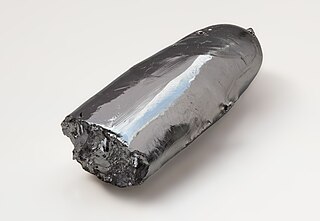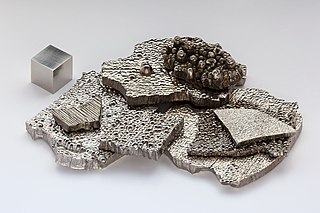
Iridium is a chemical element; it has symbol Ir and atomic number 77. A very hard, brittle, silvery-white transition metal of the platinum group, it is considered the second-densest naturally occurring metal with a density of 22.56 g/cm3 (0.815 lb/cu in) as defined by experimental X-ray crystallography. 191Ir and 193Ir are the only two naturally occurring isotopes of iridium, as well as the only stable isotopes; the latter is the more abundant. It is one of the most corrosion-resistant metals, even at temperatures as high as 2,000 °C (3,630 °F).

Osmium is a chemical element; it has symbol Os and atomic number 76. It is a hard, brittle, bluish-white transition metal in the platinum group that is found as a trace element in alloys, mostly in platinum ores. Osmium is the densest naturally occurring element. When experimentally measured using X-ray crystallography, it has a density of 22.59 g/cm3. Manufacturers use its alloys with platinum, iridium, and other platinum-group metals to make fountain pen nib tipping, electrical contacts, and in other applications that require extreme durability and hardness.

Ruthenium is a chemical element; it has symbol Ru and atomic number 44. It is a rare transition metal belonging to the platinum group of the periodic table. Like the other metals of the platinum group, ruthenium is unreactive to most other chemicals. Karl Ernst Claus, a Russian-born scientist of Baltic-German ancestry, discovered the element in 1844 at Kazan State University and named ruthenium in honor of Russia. Ruthenium is usually found as a minor component of platinum ores; the annual production has risen from about 19 tonnes in 2009 to some 35.5 tonnes in 2017. Most ruthenium produced is used in wear-resistant electrical contacts and thick-film resistors. A minor application for ruthenium is in platinum alloys and as a chemistry catalyst. A new application of ruthenium is as the capping layer for extreme ultraviolet photomasks. Ruthenium is generally found in ores with the other platinum group metals in the Ural Mountains and in North and South America. Small but commercially important quantities are also found in pentlandite extracted from Sudbury, Ontario, and in pyroxenite deposits in South Africa.

A noble metal is ordinarily regarded as a metallic chemical element that is generally resistant to corrosion and is usually found in nature in its raw form. Gold, platinum, and the other platinum group metals are most often so classified. Silver, copper, and mercury are sometimes included as noble metals, but each of these usually occurs in nature combined with sulfur.
A period 6 element is one of the chemical elements in the sixth row (or period) of the periodic table of the chemical elements, including the lanthanides. The periodic table is laid out in rows to illustrate recurring (periodic) trends in the chemical behaviour of the elements as their atomic number increases: a new row is begun when chemical behaviour begins to repeat, meaning that elements with similar behaviour fall into the same vertical columns. The sixth period contains 32 elements, tied for the most with period 7, beginning with caesium and ending with radon. Lead is currently the last stable element; all subsequent elements are radioactive. For bismuth, however, its only primordial isotope, 209Bi, has a half-life of more than 1019 years, over a billion times longer than the current age of the universe. As a rule, period 6 elements fill their 6s shells first, then their 4f, 5d, and 6p shells, in that order; however, there are exceptions, such as gold.
The platinum-group metals (PGMs), also known as the platinoids, platinides, platidises, platinum group, platinum metals, platinum family or platinum-group elements (PGEs), are six noble, precious metallic elements clustered together in the periodic table. These elements are all transition metals in the d-block.

Group 8 is a group (column) of chemical elements in the periodic table. It consists of iron (Fe), ruthenium (Ru), osmium (Os) and hassium (Hs). "Group 8" is the modern standard designation for this group, adopted by the IUPAC in 1990. It should not be confused with "group VIIIA" in the CAS system, which is group 18, the noble gases. In the older group naming systems, this group was combined with groups 9 and 10 and called group "VIIIB" in the Chemical Abstracts Service (CAS) "U.S. system", or "VIII" in the old IUPAC (pre-1990) "European system". The elements in this group are all transition metals that lie in the d-block of the periodic table.

Group 9, by modern IUPAC numbering, is a group (column) of chemical elements in the d-block of the periodic table. Members of Group 9 include cobalt (Co), rhodium (Rh), iridium (Ir) and meitnerium (Mt). These elements are among the rarest of the transition metals.

Sperrylite is a platinum arsenide mineral with the chemical formula PtAs2 and is an opaque metallic tin white mineral which crystallizes in the isometric system with the pyrite group structure. It forms cubic, octahedral or pyritohedral crystals in addition to massive and reniform habits. It has a Mohs hardness of 6–7 and a very high specific gravity of 10.6.
Osmium compounds are compounds containing the element osmium (Os). Osmium forms compounds with oxidation states ranging from −2 to +8. The most common oxidation states are +2, +3, +4, and +8. The +8 oxidation state is notable for being the highest attained by any chemical element aside from iridium's +9 and is encountered only in xenon, ruthenium, hassium, iridium, and plutonium. The oxidation states −1 and −2 represented by the two reactive compounds Na
2[Os
4(CO)
13] and Na
2[Os(CO)
4] are used in the synthesis of osmium cluster compounds.

A native metal is any metal that is found pure in its metallic form in nature. Metals that can be found as native deposits singly or in alloys include aluminium, antimony, arsenic, bismuth, cadmium, chromium, cobalt, indium, iron, manganese, molybdenum, nickel, niobium, rhenium, selenium, tantalum, tellurium, tin, titanium, tungsten, vanadium, and zinc, as well as the gold group and the platinum group. Among the alloys found in native state have been brass, bronze, pewter, German silver, osmiridium, electrum, white gold, silver-mercury amalgam, and gold-mercury amalgam.
Louis Jean-Pierre Cabri (born February 23, 1934, in Cairo) is an eminent Canadian scientist in the field of platinum group elements (PGE) mineralogy with expertise in precious metal mineralogy and base metals at the Canada Centre for Mineral and Energy Technology (CANMET). First as Research Scientist and later as Principal Scientist (1996–1999). In the 1970s he discovered two new Cu–Fe sulfide minerals, "mooihoekite" and "haycockite". In 1983 Russian mineralogists named a new mineral after him: cabriite (Pd2SnCu).
Stillwaterite is a palladium arsenide mineral which has a general formula of Pd8As3. Stillwaterite was first discovered in the Banded and Upper zones of the Stillwater igneous complex in Montana, United States, and has been reported in the Lac-des-Iles area of Ontario, Canada. Outside of North America, this rare mineral has been found in northern Finland.
Tetrachloride may refer to:
Pentafluoride may refer to:

Native element minerals are those elements that occur in nature in uncombined form with a distinct mineral structure. The elemental class includes metals, intermetallic compounds, alloys, metalloids, and nonmetals. The Nickel–Strunz classification system also includes the naturally occurring phosphides, silicides, nitrides, carbides, and arsenides.
Hexamolybdenum is a molybdenum dominant alloy discovered during a nanomineralogy investigation of the Allende meteorite. Hexamolybdenum was discovered in a small ultrarefractory inclusion within the Allende meteorite. This inclusion has been named ACM-1. Hexamolybdenum is hexagonal, with a calculated density of 11.90 g/cm3. The new mineral was found along with allendeite. These minerals, are believed to demonstrate conditions during the early stages of the Solar System, as is the case with many CV3 carbonaceous chondrites such as the Allende meteorite. Hexamolybdenum lies on a continuum of high-temperature alloys that are found in meteorites and allows a link between osmium, ruthenium, and iron rich meteoritic alloys. The name hexamolybdenum refers to the crystal symmetry and the molybdenum rich composition. The Allende meteorite fell in 1969 near Pueblito de Allende, Chihuahua, Mexico.

Rutheniridosmine is a naturally occurring mineral alloy of the elements ruthenium, iridium and osmium with the formula of (Ir,Os,Ru). Rutheniridosmine occurs as hexagonal, opaque, silver-white, metallic grains with a Mohs hardness of six. Platinum, palladium, rhodium, iron, and nickel occur as impurities.

Ferronickel platinum is a very rarely occurring minerals from the mineral class of elements (including natural alloys, intermetallic compounds, carbides, nitrides, phosphides and silicides) with the chemical composition Pt2FeNi and thus is chemically seen as a natural alloy, more precisely an intermetallic compound of platinum, nickel and iron in a ratio of 2:1:1.











